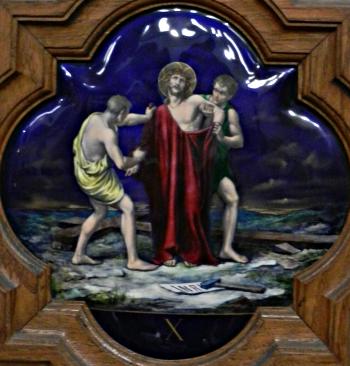
Stations of the Cross. X: Jesus is stripped of his garments
Finally Jesus reaches the place of execution, where he is stripped of his garments so that he may hang naked before the vilification of the crowd. As he is prepared for crucifixion, he is offered a drink, bitter yet intoxicating, which mocks his thirst but offers the prospect of some release as a sedative. Yet he refuses, ready to embrace his fate with as clear a mind as he can muster. Both this act and the soldiers' carrying off of his clothing as a trophy echo the Old Testament prohecies of the fate of the Messiah who was to come, and confirm the sacrifice of Golgotha as a destiny foretold.
Matthew 27: 33-36 When they had reached a place called Golgotha, that is, the place of the skull, they gave him wine to drink mixed with gall, which he tasted but refused to drink. When they had finished crucifying him they shared out his clothing by casting lots, and then sat down and stayed there keeping guard over him.
The artist uses a bold palette of colours. Against the deep blue background, there is a whirl of primary red, green and plue, in the midst of which the pale flesh of Jesus draws the eye inexorably to the patient and humble face of the Saviour. On the ground in front lies the placard that will be attached to his Cross - 'Jesus of Nazareth, King of the Jews'.
Jesus is stripped as an act of humiliation. How ready we are to do the same in theatres of conflict. In concentration camps or military detention centres, we are are not content to imprison those we think of as enemies. Too often we turn to torture and humiliation to show off our power over them. Too often? Why do we ever stoop so low?
Jesus unclothed shows us God incarnate, in essence, unshielded from the world by the layers of clothing that the world uses to express power, or richness, or fashion.
